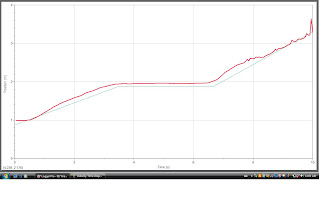 |
1. Stand 1 meter away from the origin, and stay for 1 second. 2.Walk 1.5 meter away from the origin in 2 seconds with constant speed. 3. Stand 2.5 meter away from the origin, and stay for 3 seconds.4. Walk 0.75 meter toward the origin in 1.5 seconds with constant speed. 5. Stand 1.75 meter away from the origin, and stay for 2.5 seconds. |
 | ||
| This is a d->t graph |
1. Stand 3 meter away from the origin, and walk 1.5 meter toward the origin in 3 seconds, with constant speed.
2. Stand 1.5 meter away from the origin, and stay for 1 second.
3. Walk 1 meter toward the origin in 1 second with constant speed.4. Stand 0.5 meter away from the origin, and stay for 2 seconds.
5. Walk 2 meter away from the origin in 3 seconds.
 |
| 1. Stand 0.8 meter away from the origin, and walk 1 meter away from the origin in 3.5 seconds with constant speed. 2. Stand 1.8 meter away from the origin, and stay for 3 seconds. 3. Walk 1.3 meter away from the origin in 3 seconds. |
 |
This is a v->t (velocity and time) graph
1. Speed up for 4 seconds. 2. Walk at a speed of 0.5m/s and move away from the origin for 2 seconds. 3. Walk at a speed of 0.4m/s and move toward the origin for 3 seconds. 4. Stay for 1 second.Translation from Velocity to Acceleration 1. The acceleration is 0.1m/s^2, and the line is on the positive side. 2. There is no acceleration. 3. There is no acceleration. 4. There is no acceleration. |
 |
This is a velocity-time graph 1. Stay for 2 seconds. 2. Walk at a velocity of 0.5m/s away from the origin for 3 seconds. 3. Stay for 2 seconds. 4. Walk at a velocity of 0.5m/s toward the origin for 3 seconds. Translation from Velocity to Acceleration 1. There is no acceleration. 2. There is no acceleration. 3. There is no acceleration. 4. There is no acceleration. |
 |
This is an acceleration graph Translation from Acceleration to Velocity 1. Walk at a velocity of 0.35m/s away from the origin for 3 seconds. 2. Speed up, still away from the origin, for 0.25 second. 3. Slow down, now toward the origin, for 0.25 second. 4. Walk at a velocity of 0.35m/s toward the origin for 3 seconds. 5. Slow down, toward the origin, for 0.25 second. 6. Stay for 3 seconds. 1. There is no acceleration. 2. The line is on the negative side. 3. The line is on the negative side. 4. There is no acceleration. 5. The line is on the positive side. 6. There is no acceleration. |
No comments:
Post a Comment